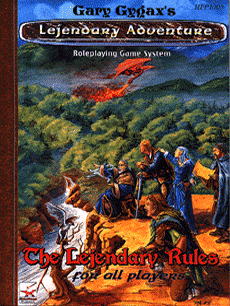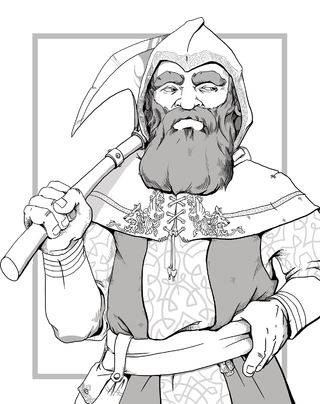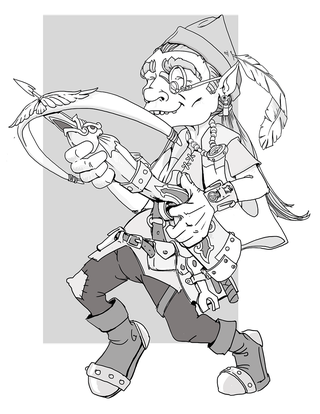This article needs additional citations for verification .(January 2015) |

Dragonstar is a science fantasy game created by Fantasy Flight Games [1] for Wizards of the Coast's D20 role-playing game system. [2]
This article needs additional citations for verification .(January 2015) |

Dragonstar is a science fantasy game created by Fantasy Flight Games [1] for Wizards of the Coast's D20 role-playing game system. [2]
The game's setting is a galaxy under the dominion of the Dragon Empire. The Dragon Empire is an empire ruled by the ten houses of dragons. Of these houses, five are chromatic and five are metallic. The Empire is led by Mezzenbone, an evil red dragon.
Across the galaxy, fantasy races inhabit countless worlds. Scientists and archmages in the game try to come up with a logical explanation as to why the races had similar linguistic traits. Eventually, a prominent religious leader proposed a theory: all the gods of every religion were the same, just different aspects of the twelve "True Gods". These aspects were the 12 "Deitypes," short for Deity Archetypes. Deitypes are basic, primordial, archetypal icons such as The Father, The Mother, The Magus, The Smith, The Destroyer and The Trickster. Some deities have elements of two or more Deitypes. These 12 Deitypes seeded similarities all across the life-supporting worlds of the galaxy. This theory led to a new religion that formed the basis of an emerging unified interstellar culture. The dragons eventually rose to dominate and unite this culture under a single massive Dragon Empire that rules all of inhabited space. The dragons would assimilate newly discovered inhabited planets along the edge of the Empire, also known as the Outlands.
The Dragonstar setting can easily combine preexisting Dungeons & Dragons and other D20 material and settings. A PC group can be made up of character races and classes in any combination and be rationally integrated with little work. It is similar to the classic Spelljammer setting by TSR, although Dragonstar is more of a blend of science fantasy and space opera. A basic premise of the setting is that advanced technology is sufficient to handle most tasks, but things that are considered impossible by our current understanding of physics, such as faster-than-light travel between stars, force-fields, and teleportation, are accomplished with magic. Characters use a combination of technology, conventional weaponry and magic in combat.
The game was first announced on the Fantasy Flight website on December 5, 2001.[ citation needed ] The space opera science fantasy Dragonstar (2001) was the first d20 setting that Fantasy Flight Games published; FFG published several supplements for the setting between 2001-2003. [3] : 346 Sometime between 2007 and 2008, the company decided to end support for the game.[ citation needed ] The game still has a fully functioning website with a support page and message boards. [4]
In a review of Dragonstar in Black Gate , Tom Doolan said "Perhaps one of the biggest strengths is the flexibility. A Dragonstar game can include traditional fantasy, space opera, hard science-fiction, horror, or any other adventure type you can think of (my own highly successful campaign was a blend of Firefly and D&D)." [5]
The following products were published by Fantasy Flight games for the Dragonstar campaign setting:
The following products were licensed for publication by Mystic Eye Games (now defunct) for the Dragonstar Campaign setting:

Star Frontiers is a science fiction role-playing game produced by TSR from 1982 to 1985. The game offers a space opera action-adventure setting.
Forgotten Realms is a campaign setting for the Dungeons & Dragons (D&D) fantasy role-playing game. Commonly referred to by players and game designers as "The Realms", it was created by game designer Ed Greenwood around 1967 as a setting for his childhood stories. Several years later, it was published for the D&D game as a series of magazine articles, and the first Realms game products were released in 1987. Role-playing game products have been produced for the setting ever since, in addition to novels, role-playing video game adaptations, comic books, and the film Dungeons & Dragons: Honor Among Thieves.

Spelljammer is a campaign setting originally published for the Advanced Dungeons & Dragons role-playing game, which features a fantastic outer space environment. Subsequent editions have included Spelljammer content; a Dungeons & Dragons 5th edition setting update was released on August 16, 2022.
The drow or dark elves are a dark-skinned and white-haired subrace of elves connected to the subterranean Underdark in the Dungeons & Dragons fantasy roleplaying game. The drow have traditionally been portrayed as generally evil and connected to the evil spider goddess Lolth. However, later editions of Dungeons & Dragons have moved away from this portrayal and preassigned alignment. More recent publications have explored drow societies unconnected to Lolth.
The d20 System is a role-playing game system published in 2000 by Wizards of the Coast, originally developed for the 3rd edition of Dungeons & Dragons. The system is named after the 20-sided dice which are central to the core mechanics of many actions in the game.

A campaign setting is usually a fictional world which serves as a setting for a role-playing game or wargame campaign. A campaign is a series of individual adventures, and a campaign setting is the world in which such adventures and campaigns take place. Usually a campaign setting is designed for a specific game or a specific genre of game. There are numerous campaign settings available both in print and online. In addition to published campaign settings available for purchase, many game masters create their own settings, often referred to as "homebrew" settings or worlds.
The tiefling is a fictional humanoid race in the Dungeons & Dragons (D&D) fantasy roleplaying game. Originally introduced in the Planescape campaign setting in the second edition of Advanced Dungeons & Dragons as a player character race for the setting, they became one of the primary races available for player characters in the fourth edition of the game.
Abeir-Toril is the fictional planet that makes up the Forgotten RealmsDungeons & Dragons campaign setting, as well as the Al-Qadim and Maztica campaign settings, and the 1st edition version of the Oriental Adventures campaign setting.

The Forgotten Realms Campaign Setting is a role-playing game sourcebook first published by TSR in 1987 for the first edition of the fantasy role-playing game Advanced Dungeons & Dragons that describes the campaign setting of the Forgotten Realms. It contains information on characters, locations and history. Various revised and updated editions have been produced over the years.

Lejendary Adventure is a role-playing game created by Gary Gygax, the co-creator of Dungeons & Dragons (D&D) and creator of Advanced Dungeons & Dragons (AD&D).

The Palladium Fantasy Role-Playing Game is a fantasy role-playing game published by Palladium Books in 1983.

A dwarf, in the Dungeons & Dragons (D&D) fantasy roleplaying game, is a humanoid race, one of the primary races available for player characters. The idea for the D&D dwarf comes from the dwarves of European mythologies and J. R. R. Tolkien's novel The Lord of the Rings (1954–1955), and has been used in D&D and its predecessor Chainmail since the early 1970s. Variations from the standard dwarf archetype of a short and stout demihuman are commonly called subraces, of which there are more than a dozen across many different rule sets and campaign settings.
The flexibility of the Dungeons & Dragons (D&D) game rules means that Dungeon Masters (DM) are free to create their own fantasy campaign settings. For those who wanted a pre-packaged setting in which to play, TSR, Wizards of the Coast (WotC), and other publishers have created many settings in which D&D games can be based; of these, the Forgotten Realms, an epic fantasy world, has been one of the most successful and critically acclaimed settings. Many campaign settings include standard sword and sorcery environments, while others borrow Asian, Central American, swashbuckling, horror and even space-travel themes.

In the Dungeons & Dragons fantasy role-playing game, goblins are a common and fairly weak race of evil humanoid monsters. Goblins are non-human monsters that low-level player characters often face in combat.

Ptolus, subtitled "Monte Cook's City by the Spire", is a fantasy role-playing game campaign setting published by Malhavoc Press in 2006 that details a single city and the dungeons that lie beneath it. Ptolus uses the rules of the third edition of Dungeons & Dragons — the d20 System — under the terms of Wizards of the Coast's Open Game License. At 672 pages, it was the largest D&D supplement that had been published up to that time.

James Michael Ward III was an American game designer and fantasy author who worked for TSR, Inc. for more than 20 years, most notably on the role-playing game Dungeons & Dragons. He wrote various books relating to Dungeons & Dragons, including guidebooks such as Deities & Demigods, and novels including Pool of Radiance, based on the computer game of the same name.
David Noonan is an author of several products and articles for the Dungeons & Dragons fantasy role-playing game from Wizards of the Coast.

A tabletop role-playing game, also known as a pen-and-paper role-playing game, is a classification for a role-playing game (RPG) in which the participants describe their characters' actions through speech, and sometimes movements. Participants determine the actions of their characters based on their characterization, and the actions succeed or fail according to a set formal system of rules and guidelines, usually containing Dice-Rolling. Within the rules, players have the freedom to improvise; their choices shape the direction and outcome of the game.

Character race is a descriptor used to describe the various sapient species and beings that make up the setting in modern fantasy and science fiction. In many tabletop role-playing games and video games, players may choose to be one of these creatures when creating their player character (PC) or encounter them as a non-player character (NPC). "People" is to be taken in the broader sense, and may encompass ethnic groups, species, nationality or social groups.

In the Dungeons & Dragons fantasy role-playing game, gnomes are one of the core races available for play as player characters. Some speculate that they are closely related to dwarves; however, gnomes are smaller and more tolerant of other races, nature, and magic. Depending on the setting and subrace, they are often skilled with illusion magic or engineering. Gnomes are small humanoids, standing 3–3.5 feet (91–107 cm) tall.